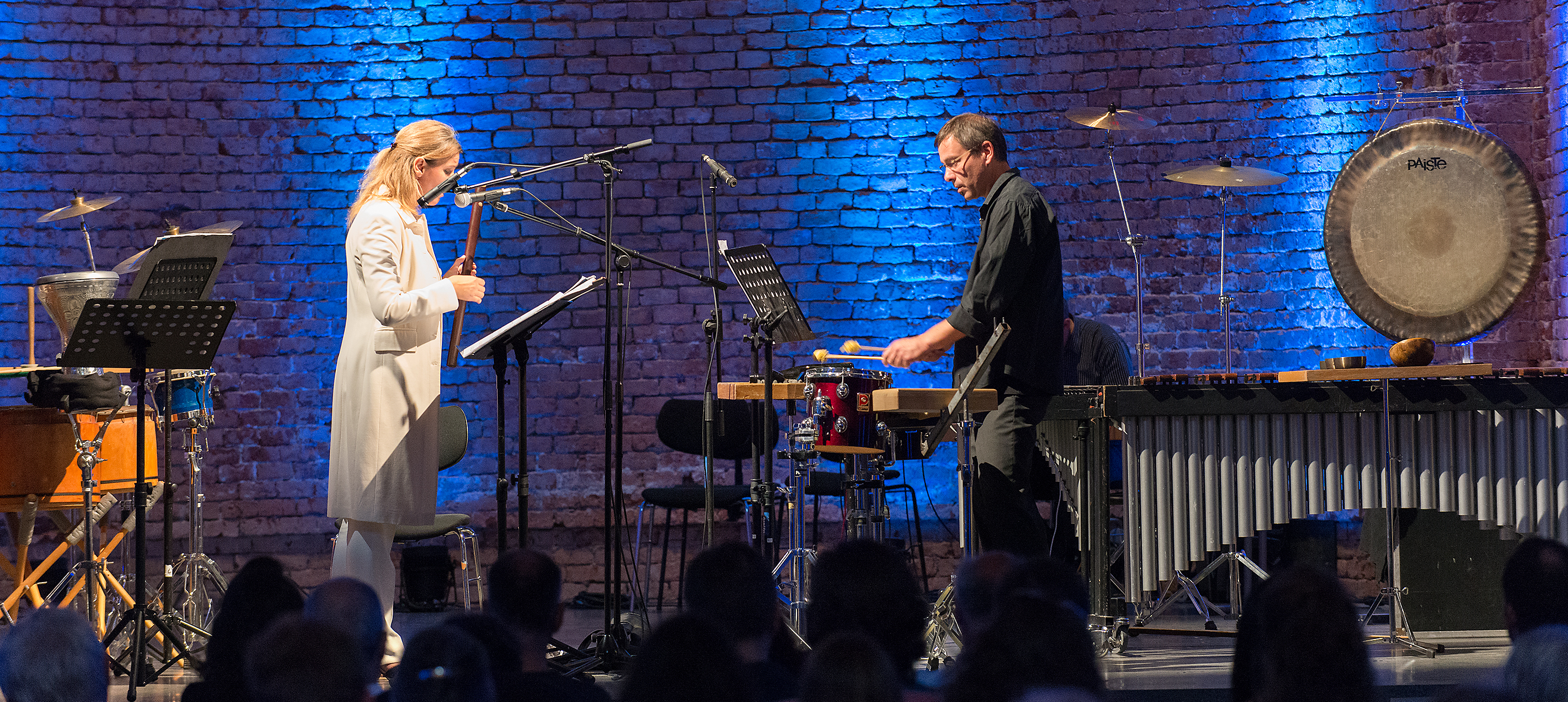A E N I G M A E T S T U P O R
IRIS LICHTINGER Recorders, Soprano & STEFAN BLUM Percussion
Astonishing closeness as well as enigmatic distance of sound speech will be experienced in this intimate concert of early and new music, when medieval sounds meet contemporary works for voice, recorder and percussion. In this concert, works by composers of German-Indian, Israeli-Palestinian, Mexican, American and German origin reflect different approaches to faith that ultimately culminate in spiritual unity. The concert programme spans almost 1000 years - with fascinating works by Hildegard von Bingen, Sandeep Bhagwati, Frederic Rzewski, Mario Lavista, Samir Odeh-Tamimi and others.
Program
Hildegard von Bingen (1098-1179) O quam mirabilis (from: "Symphonia armonie celestium revelationum", Giant Codex )
Sandeep Bhagwati (*1963) Nirgun Bhajan (2013)
Samir Odeh-Tamimi (*1970) Li-Sabbrá (2005)
Anonymous (14th century) (from: London, British Library, MS. Add. 29987) Istampitta Im pro; Lamento di Tristano
Mario Lavista (*1943) Ofrenda (1986)
Stefan Blum (*1963) Moving Skin Pattern (2009)
Anonymous (14th century) (from: London, British Library, MS. Add. 29987) Istanpitta Ghaetta
Frederic Rzewski (*1938) To the Earth (1985)
PRESS
Aenigma et Stupor "Enigmatic and solidified" in concert with Iris Lichtinger and Stefan Blum
The concert program presented by Iris Lichtinger (recorder, voice) and Stefan Blum (percussion) in the "Utopia Toolbox" spanned almost 1,000 years of history. Both artists are internationally in demand, lecturers at the Leopold Mozart Center of the University of Augsburg and versatile: Iris Lichtinger is professionally active in both early and new music as well as a tango pianist, Stefan Blum from Munich is well known as a percussionist, composer and percussion teacher in contemporary music.
Spirituality - in the context of the Luther Year - was the central theme of the program "Aenigma et Stupor". The works by composers of German-Indian, Israeli-Palestinian, Mexican, American and German origin reflect different approaches to faith, which ultimately lead to spiritual unity. Right at the beginning, Hildegard von Bingen's "O quam mirabilis," with Renaissance flute sounds reminiscent of Gregorian chant over monotonous gong beats, transported the audience to a distant world. In "Nirgun Bhajan" by the Indian composer and music researcher Sandeep Bhagwati, Lichtinger declaimed a text from the tradition of North Indian spiritual songs over an electronically played drone and seven colorfully mixed percussion instruments. The resulting seven tone levels defined the improvised melodies of both musicians and whirred through the hall as circling and twisting scales.Shattering "Li - Sabbrá" by Palestinian-Israeli composer Samir Odeh-Tamimi, recalling the 1982 massacre in the refugee camps of Sabbrá and Shattila in southern Beirut. Lichtinger and Blum articulated the sounds of war, the fearful cries of the children, the killing machinery in a frighteningly realistic, merciless tone. Afterwards, there was an affected silence in the room. It dissolved in medieval flair: Blum's Darbuka and Lichtinger's virtuoso soprano flute in the anonymously composed Estampien "Istanpitta In pro", "Lamento di Tristano" and "Ghaetta", taken from a Tuscan/Aumbrian manuscript. In contrast, the work "Ofrenda" by the Mexican composer Mario Lavista, a requiem, which Iris Lichtinger intoned sometimes with flute solo, sometimes fascinatingly in two voices with flute and her own voice, put the listeners under a mystical spell. One of the highlights of the evening was certainly Stefan Blum's "Moving Skin Pattern", an increasingly dense and dynamically growing modification of several patterns, which the composer presented on nine natural skin drums. Flower pots symbolizing the fragility of earth and people served as sonorous percussion instruments in the concluding work "To the earth" by American Frederic Rzewski - rhythmically coordinated by Blum with Lichtinger's speaking voice, which recited into the room in dactylic hexameters a prayer to Gäa, the goddess of the earth, dating from the 7th century. The surging applause came from an audience that was thrilled, but also moved, touched and fascinated.
NMZ 9 / 2017
Percussionist Stefan Blum studied at the Musikhochschule in Munich and has since been active as a soloist, chamber and orchestral musician. He has been invited as a soloist by several orchestras and ensembles, including Klangforum Wien, the Bavarian Radio Symphony Orchestra, and the WDR Symphony Orchestra. As a chamber musician in the ensemble trioLog münchen, he collaborates with renowned composers of new music, whose works he has premiered at leading festivals. Successful engagements have led to repeated invitations to the Salzburg Festival, Steirischer Herbst Graz, Ultraschall Festival Berlin, Frankfurt Feste, Wien Modern, Rheingau Music Festival, Begegnungen Prague, Donaueschinger Musiktage, Festival de piano de la Roque d`Antheron, Festival for Chamber Music Chelyabinsk, Kissinger Sommer, etc. He is a regular guest in the ensemble of MusikFabrik NRW. He has made recordings for Bayerischer Rundfunk, Hessischer Rundfunk, Deutschlandfunk, Radio Bremen, Südwestfunk Baden Baden and Österreichischer Rundfunk, as well as recordings for Sony Classics, Wergo and Deutsche Grammophon, and tours have taken him to Japan, China, South America, the USA, Russia and many countries in Europe.Stefan Blum is a lecturer at the Vocational School of Music in Krumbach and since 2000 has led the percussion class at the Leopold Mozart Center of the University of Augsburg.


